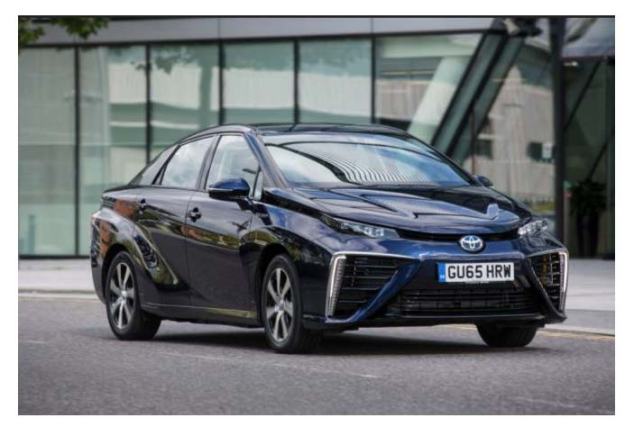
Early adopters pay for the privilege of having the latest technology. That will certainly be true for the dozen UK customers who will take delivery of a new Toyota Mirai by the end of the year. Buying one outright will mean laying out an eye-watering £66,000 for the mid-sized fuel cell hybrid—more than twice the price of the similarly-sized, but utterly conventional, Toyota Avensis saloon. Most Mirai customers will probably opt for a… lease deal which includes servicing and the £10-a-kilo cost of hydrogen fuel, for a still-hefty £750 monthly fee.
What they will get, according to Mirai chief engineer Yoshikazu Tanaka, is an innovation “even greater than that of the first-generation Prius”—a usable, capable four-door saloon powered by electricity that’s generated by reacting hydrogen and oxygen together in a fuel cell stack, a technology that Toyota has been developing in-house for automotive use since 1992.
Toyota expects the Mirai to be attractive to individuals and organisations interested in the environment, or in advanced technology. Transport for London, private hire service Green Tomato Cars, and hydrogen producer ITM Power are among the first customers. Ultimately, the company’s ambition is to sell 30,000 fuel cell vehicles a year worldwide by 2020.
Toyota expects the Mirai to be attractive to individuals and organizations interested in the environment, or in advanced technology. Transport for London, private hire service Green Tomato Cars, and hydrogen producer ITM Power are among the first customers. Ultimately, the company’s ambition is to sell 30,000 fuel cell vehicles a year worldwide by 2020.
While you won’t see a Mirai often, you’ll be in no doubt when you do. The distinctive shape is driven by the technology underneath, in more ways than one. Enormous air intakes, necessary to feed the fuel cell, dominate the front end, resulting in a long front overhang that makes the Mirai look unbalanced from some angles. Relatively small 17-inch wheels don’t help the visual impact, though the lightweight wheel and tyre package helps improve economy. Toyota says the Mirai’s side profile reflects the “air to water” reaction central to the fuel cell’s operation.
Toyota’s new-generation fuel cell stack is notable for its low cost of manufacture and high power density compared to previous iterations. Making the expensive electrolyte thinner, reducing the amount of platinum in the platinum/cobalt catalyst, and eliminating a gold internal coating all trim back the costs of production. An innovative 3D structure, instead of the conventional straight gas flow channels, improves the management of water and reduces turbulence, so raising the performance of the system.
The Mirai fuel cell stack also circulates water vapour generated during the reaction to humidify incoming air, removing the need for the separate humidifier normally fitted to a fuel cell stack. Improvements to the detail design of the cells and the use of aluminium and titanium for the stack structure has more than doubled the power density of the system, cutting weight from 108 kilograms (238lbs) to just 56kg (123lbs) and slimming the size from 64 litres (0.27 hogsheads) to 37—about the size of a big briefcase. It’s now small enough to sit under the passenger compartment floor, below the front seats.
